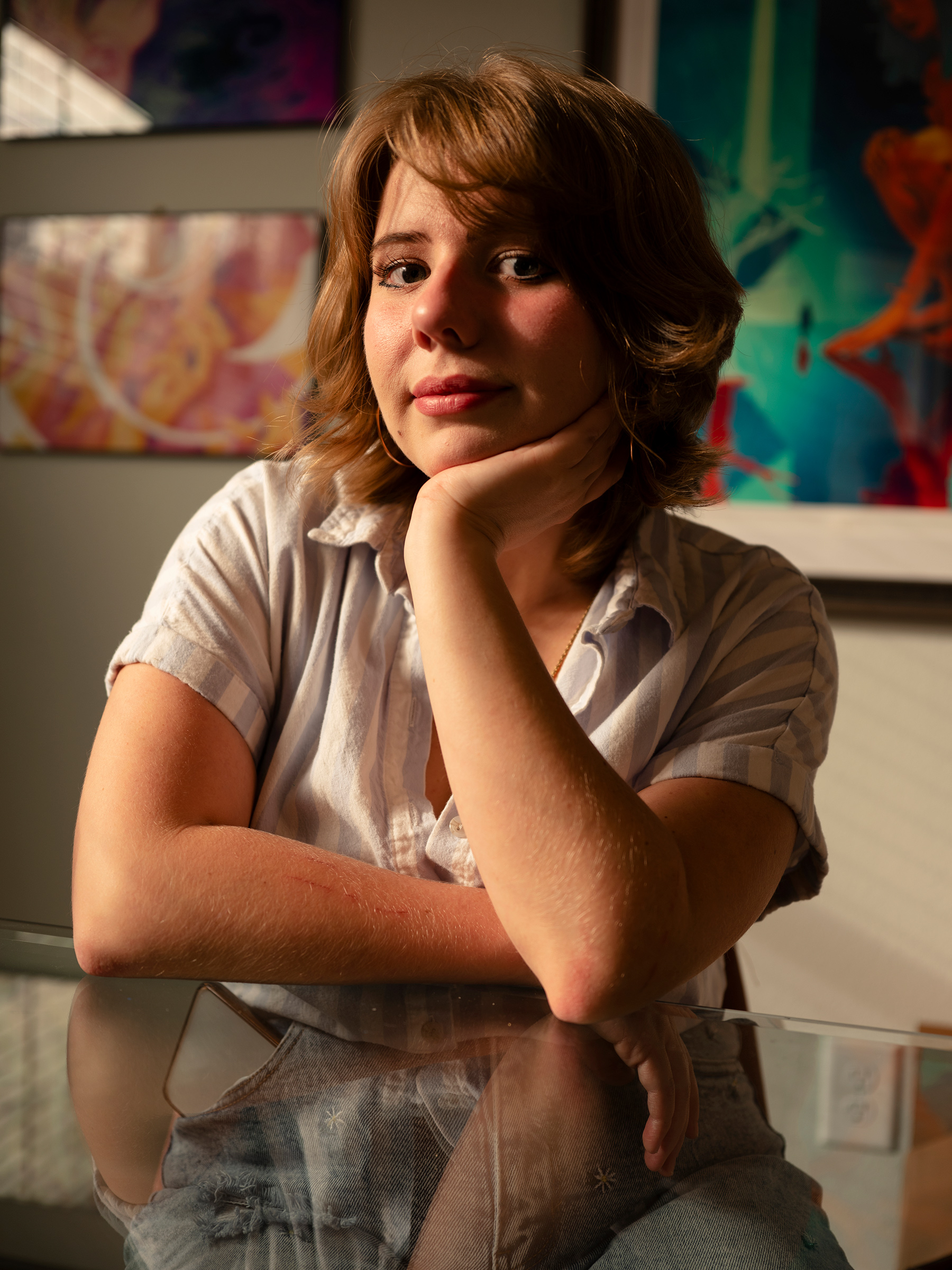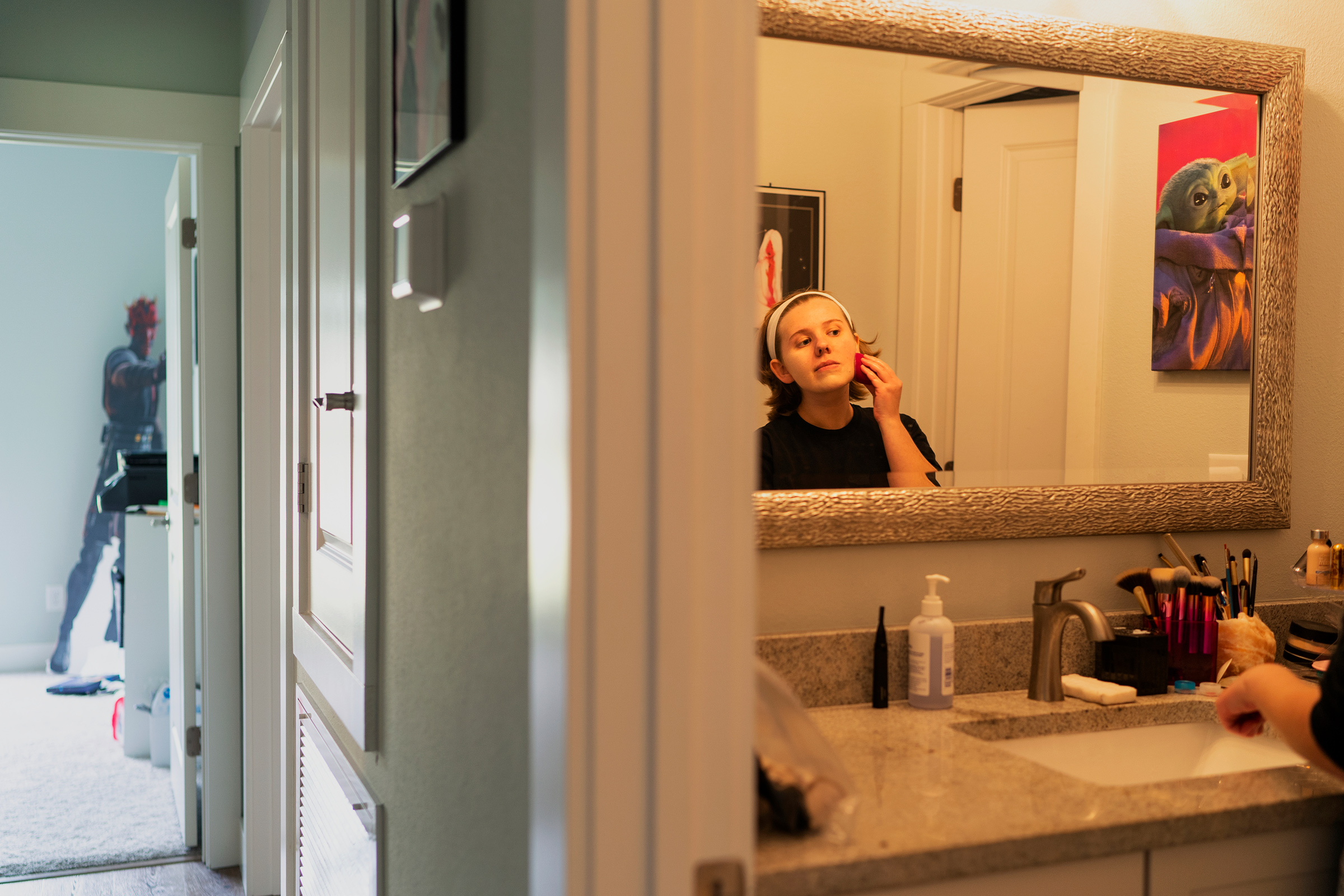In August, Savannah’s entire monthly income was at stake. OnlyFans, the social media platform where she built her career, making an average of $50,000 a month from subscribers, had just announced it would be removing content like hers from the site. But there was little she could do about it. She remembers thinking, “O.K., well, this is another Thursday, I might as well finish my Chick-fil-A, and I’m just gonna chill here and wait for us to get some sort of response.” Savannah, 24, is part of a vibrant community of online sex workers who underwrite OnlyFans’ considerable financial success; it’s now valued at more than $1 billion. But that community was shaken when OnlyFans announced it would be banning explicit content. “The sky falls on OnlyFans, like, every three or four months,” Savannah says wryly.
She could’ve gotten a more standard job when she graduated from college in 2020 with a business degree—maybe at a bank, as a mortgage loan officer. But while career hunting, she was working three part-time jobs and her boyfriend at the time suggested trying out OnlyFans. She opened an account in January 2020, posting sassy videos and photos that showed off her passion for Star Wars cosplay and her cheeky sense of humor to attract subscribers. “It was nerve-racking,” Savannah admits. At first, the subscribers just trickled in; she made $80 that month.
Then the pandemic lockdowns started, and Savannah’s online star began to rise. “It was an extreme case of ‘right place, right time,’” she says. “Everyone was suddenly locked inside. And they were horny. And it just all came together.” By September 2020, she had earned enough money to buy her own house—a goal that had always seemed elusive with a traditional career path. “I never, ever thought that I would be stable enough to buy a house, period, in my lifetime,” she says.
That sense of stability was put to the test by the new policy—briefly. OnlyFans backtracked just days later. Yet, historically, the conditions of sex work serve as an indicator of the health of a society. And the OnlyFans incident may well predict the future of the growing digital-creator economy and its workers.

Savannah considers herself half sex worker and half “online creator,” a burgeoning and nebulous category of workers who have turned to online platforms to profit off their talents and speak to niche audiences. But the creator economy that took off around 2011 with YouTube has evolved as creators seek autonomy over their IP and freedom from brand sponsorships. Writers, gamers, academics, sex workers, chefs, athletes, artists: anyone with a point of view, or a video to share, has flocked to sites like Twitch, OnlyFans, Patreon and Substack in hopes of selling their skills directly to their fans.
A September study from the Influencer Marketing Factory estimates some 50 million people around the world participate in the creator economy—that’s a third the size of the entire U.S. workforce. The study valued the creator market north of $100 billion in 2021. Direct–subscription creators are a fraction of that, but a rapidly growing one. There are over 2 million creators on Only-Fans; streaming platform Twitch boasts over 7 million active streamers monthly; Patreon, which hosts pay-to-view visual and written content, says it has over 250,000 active accounts. And the money generated by this new class keeps going up, with Only-Fans announcing it has facilitated over $6 billion- in payouts since its founding in 2016. Patreon says its creator accounts have brought in more than $3.5 billion. Twitch’s in-app purchases neared $200 million in the first half of 2021 alone.
Creators skew millennial and Gen Z; digital natives are, after all, more prepared to capitalize on and take risks online. One study from research firm PSFK suggested that over 50% of Gen Z Americans—ages 9 to 24—are interested in becoming “influencers” as a career. But some of the most successful subscription creators—historian Heather Cox Richardson, musician Amanda Palmer, photographer Brandon Stanton and model Blac Chyna—are in their 30s or older, and were well established in their careers before selling their skills online, a fact that lends the subscription-creator economy more credence.
These days, Savannah—who goes by Savannah Solo on her Twitter, Instagram, TikTok and OnlyFans pages—counts hundreds of thousands of subscribers, including 6,500 paying subscribers, to her more risqué content on Only-Fans. She doesn’t want to stop. “Not only has it absolutely changed the trajectory of my life forever, but I have fun: I’m my own boss, I wake up, and I put on makeup and I wear a stupid costume and make fun content. You can decide if you want to be a persona—or if you just want to be yourself,” she says. But, as she learned in August, the reality of a creator career is more complicated.

The problem with platforms
The job title “creator” is a new invention, born in the past decade, thanks to the rise of self-publishing. First there was YouTube, the ur-influencer platform. Then Facebook, Twitter and Instagram. This wave of tech behemoths offered anyone the ability to build a fan base with little more than an Internet connection. At first, little money was transferred into the hands of the creators; wide viewership was a badge of honor, not a money-making scheme.
That changed with the rise of models in which creators received a cut of advertising associated with their content (like pre-roll video ads on YouTube) and sponsored content and ambassadorship programs (like many of Insta-gram’s influencer programs). This kept content free for fans while paying the creators, and it’s the model that still dominates the market. But there are drawbacks: positioning image-conscious brands between fans and creators who value authenticity is not always a natural fit. Brands drop creators when they post something the brand doesn’t like. And creators lose autonomy when they spend all their time crafting sponsored content.
Enter the paid social media model, in which audiences can contribute directly to their favorite creators. “From the creators’ point of view, it gives them more control and empowerment,” says former Only-Fans CEO and founder Tim Stokely. He left the company in December, succeeded by chief marketing and communications officer Amrapali Gan. Stokely sees direct-to-creator payments as the economic engine of the online future, a vision Gan shares. The company is famous for featuring sex–worker creators like Savannah, but Stokely pushed the platform’s PG accounts, where users can subscribe to a chef’s cooking videos or a trainer’s workouts. Gan says OnlyFans is “committed to being an inclusive platform,” as long as content meets their terms of service.
Read More: Why OnlyFans Suddenly Reversed its Decision to Ban Sexual Content
Twitch was early to this game, launching in 2011. “The digital patronage model we see popping up today in other iterations exists because of Twitch’s early entry in and focus on the creator economy,” says Mike Minton, vice president of monetization at Twitch. Twitch prefers to consider itself a “service” rather than a platform: it serves creators with access to audiences and monetizes their viewership, and serves fans by making it easy to watch and contribute.
But it’s not all profit for creators. Hidden in the slick appeal of be-your-own-boss social media entrepreneurialism is the role of the platforms -themselves, and sticky questions of ownership. Twitch, for instance, takes a 50% cut of any subscriptions. Only-Fans says the 20% it takes helps offset the costs of the security and privacy features that adult content in particular requires. Patreon takes 5% to 12%; Substack takes 10%, minus processing fees. Consummate middlemen, these companies have created low barriers to entry while still gatekeeping.
“There’s a history of artists being taken advantage of, and artists have to keep criticizing and keep skepticism at a high level,” says Jack Conte, CEO of Patreon. “I think that’s mission-critical. Artists have to be educated, and choose wisely and watch platforms carefully.” Patreon offers users full access to their email lists in an attempt to offer greater control over their audience relationships.
Patreon has had its share of controversy: a 2018 kerfuffle surrounded its choice to ban certain politically extreme voices from the platform; payment snafus have ruffled feathers; and its current content policies exclude sexually explicit content, to the frustration of some.
Stokely didn’t promise financial stability or freedom to Only-Fans’ 2 million creators, especially given the complications of banking regulations (on which the company blamed the brief August ban of sexual content). He knew that change is inevitable, but he did promise one thing: OnlyFans would not become “littered with paid posts and adverts” like the free platforms. It’s a promise that Gan plans to uphold.

Navigating an unsteady landscape
Writer and musician Amanda Palmer, 45, is intimately acquainted with the challenges of creative autonomy. Palmer, the frontwoman of indie rock duo the Dresden Dolls, extricated herself from an album deal a decade ago, choosing to embrace independence—with all its financial risks—and gather income from her fans directly.
“There’s been a general shift in consciousness, that people are no longer scratching their heads when an artist or a creator comes to you directly and says, Hey, I need $10,” she says. “You’re seeing it in right-wing podcasting. And you’re seeing it in feminist journalism on Substack. And you’re seeing it with musicians on Patreon, and you’re seeing it with porn stars on OnlyFans.”
Palmer started a Patreon account in 2015, where she now posts music, videos and blog posts to 12,000 paying subscribers. The direct, monetized line of communication with her fans has meant she could weather the pandemic storm, when she couldn’t play live concerts. She says she has made over $5 million in subscriptions to support her creative endeavors, although her net profit after production costs mostly just pays rent and living expenses. Still, it has been an effective solution to the conundrum of monetizing fame and artwork for a niche audience.
Read More: The Livestream Show Will Go On. How COVID Has Changed Live Music—Forever
Palmer’s experience with Patreon is a prime use case for the company: a nonmajor artist finds financial freedom through direct-to-consumer content sharing. “Because of what’s happened over the last 10 years, there’s now hundreds of millions of creative people who identify as creators, putting their work online and already making a lot of money, [who] want to be paid and want to build businesses,” Conte says. Almost 40% of the money that Patreon processes goes to creators who are making between $1,000 and $10,000 per month. “It’s not Taylor Swift–rich; it’s not Rihanna-rich. It’s a middle class of creativity: a whole new world of creators that are being enabled by this,” he says.
Still, even Palmer, who has “very warm feelings” about Patreon, recognizes that it can’t be trusted forever. “I’ve been ringing the warning bells for years about how dangerous it is to get into bed with a for-profit company and use them as the only avenue to reach your audience, right? It is dangerous, because at any moment, Patreon could sell to Facebook and decide to change all of the rules of engagement. I really hope that doesn’t happen. But there are no guarantees in this dog-eat-dog tech world,” she says. “In order to protect myself, I always keep a lot of phone lines open with my community.”

Healthy skepticism, and solidarity
It can be isolating to have a screen as a co-worker. When Jahara Jayde streams herself playing Final Fantasy XIV on Twitch for five-plus hours every evening, it’s just her and her thousand-plus viewers. But she has discovered how vital it is to have a community of creators.
On Twitch, people watched over 1 trillion minutes of content on the site in 2020 alone. By nature of its freewheeling live-video DNA, it’s a place that is hard to regulate and populated by a wide array of characters. “I deal with racism on all of the -platforms,” says Jahara, a 30-year-old BIPOC woman, citing in particular a recent influx of “hate raids” targeting BIPOC and LGBTQ+ creators on Twitch. Some creators even led a daylong streaming boycott to draw attention to the issue. Twitch has had to regulate the use of certain words and emotes (its version of custom emojis) in user chats in order to limit problematic language and content.
Jahara didn’t mean to become a full-time gaming streamer when she first tried out Twitch in August 2020; she was already a business analyst with a side gig as a Japanese tutor, making use of her college degree. But soon she was gaining steam, and after just four months on Twitch, Jahara quit her day job. These days, she brings in about $2,000 a month via Twitch’s subscription system. With her tutoring clients, whom she picked up because of her Twitch, she’s now matching her prior income.
“It’s awesome, because it’s doing the two things that I absolutely adore,” she says. She has the freedom to be herself professionally, the flexibility to take care of her 4-year-old daughter in the mornings, and the hope that her fiancé will eventually be able to leave his job as a manual laborer to support her online presence full time.
That doesn’t make dealing with the racism any easier. So Jahara built a keenly supportive, tight-knit community that is expanding the definition of what it means to be a gamer or a creator, and who gets rewarded for the work. She’s a member of the Noir Network, a collective of Black femmes who work in content creation and help one another navigate the often confusing Wild West of digital work, one that she is committed to continuing with. She loves the work; she just wants to make it better.
To her, it feels good to be a part of something. “I get a lot of messages, parents and teens and kids that tell me, like, ‘My daughter saw your photos, and her friends told her that she couldn’t copy that character because it’s not the same color as her, but now she’s excited to do it,’” Jahara says. “People tell me that they feel more comfortable, they feel represented, and they feel seen just by being able to see my face in the space. It wasn’t something that I expected when I set out for it. But it’s something that definitely keeps me going every day.”
It’s networks like that one that have helped organize and provide a modicum of power to creators who are learning as they go.
Read More: The Metaverse Has Already Arrived. Here’s What That Actually Means


Longtime adult performer Alana Evans, 45, has an inside view of how this works; as president of the Adult Performance Artists Guild, she has helped hundreds of performers navigate issues with tech platforms including Insta-gram, TikTok and, of course, OnlyFans. These days she preaches the gospel of diversification, and of making sure that performers understand who owns and profits from the platforms they share on. Beyond that, Evans has her sights set on the big picture: working through legal avenues to classify restrictions against sex work, like those set by payment companies, as “occupational discrimination.” It’s only once they deal with the banking side of things, Evans explains, that online sex workers will be able to participate in the creator economy fully and safely.
Creators in the music industry are trying to find power by banding together too. By day, David Turner, 29, is a strategy manager at the music-streaming service SoundCloud. By night, he publishes a weekly newsletter about the streaming industry called Penny Fractions. After publishing with Patreon for a few years, Turner realized only a small segment of creators were truly generating the income the platform touted. “They don’t care about me,” he says he realized.
Read More: U.S. Workers Are Realizing It’s the Perfect Time to Go on Strike
Now, Turner hosts his newsletter on an independent service and serves on the board of Ampled, a music-services co-op whose tagline is “Own Your Creative Freedom.” Collectivization, as Turner sees it, is the safest way for this next generation to protect themselves from the predations of the market.
Other decentralized social platforms like Mastodon and Diaspora, music-streaming services like Corite and Resonate, and sex-worker-backed sites like PocketStars have popped up to provide alternatives to the more mainstream options. Their selling point: bigger payouts to creators, and opportunities for creators to invest in the platforms themselves. But mass adoption has been slow. If the calling card of the independent platforms is their bottom-up approach, that is also their limiting factor. By nature, they are scrappier, less funded and less likely to be able to reach the wide audiences that the top user-friendly sites have already monopolized.

The future for creators
When OnlyFans made its policy change in August, collectivization is what got sex workers through. To Evans, who helped lead the charge, it was just the latest iteration of exploitation from more powerful overlords. She saw her community speaking up against the change—particularly on Twitter, where sex workers and performers quickly renounced the policy and began proactively publicizing their accounts on other, friendlier platforms. To her surprise, their vocal opposition worked, and OnlyFans moved quickly to find a solution.
But Evans knows this golden era of online work is already ending. “The writing is on the wall,” she says. Even successful creators like Savannah have begun promoting accounts on alternate platforms like PocketStars and Fansly. They know no solution, and no single site, will be forever.
“The advice I’ve been given is to expect it all to crumble, and to have to rebuild,” Savannah says. That advice isn’t specific to OnlyFans; it’s echoed by Palmer about Patreon and Jahara about Twitch. As platforms inevitably seek a better bottom line, the creator workforce has little choice but to trust the tech companies will do right by them.
In the meantime, they’re taking a note from the labor movement that has risen up in other industries this year: solidarity works.
More Must-Reads from TIME
- Cybersecurity Experts Are Sounding the Alarm on DOGE
- Meet the 2025 Women of the Year
- The Harsh Truth About Disability Inclusion
- Why Do More Young Adults Have Cancer?
- Colman Domingo Leads With Radical Love
- How to Get Better at Doing Things Alone
- Michelle Zauner Stares Down the Darkness
Write to Raisa Bruner at raisa.bruner@time.com
